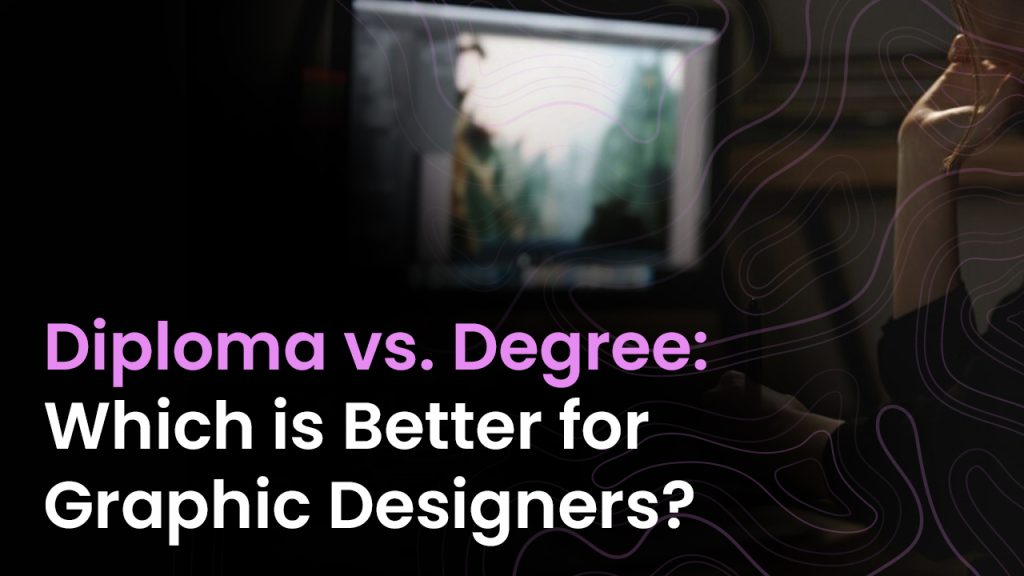Diploma vs. Degree: Which is Better for Graphic Designers?

Willing to become a graphic designer? But, are you undecided about enrolling in a degree or a diploma in graphic design? If so, you should know that you can receive useful instruction and training from both courses in graphic design. Nevertheless, having to decide between the 2 can be difficult, particularly when it will have an immediate effect on your future employment possibilities.
To assist you in making an informed choice between these two courses, we will go over a few important aspects in this blog.
| Table of Contents: What is Graphic Design? How to Become a Graphic Designer? Is a Degree or a Diploma Better for Graphic Designers? Concluding Thoughts FAQs |
What is Graphic Design?
By combining applied art, academic field, and vocation, graphic design entails presenting you with visual communications meant to convey particular messages to target audiences. You can primarily find this field in the fine arts and design, which operates on an interdisciplinary level.
How to Become a Graphic Designer?
To delve into the graphic design profession, you should have an academic background in the same domain. To upgrade your skills and current knowledge, LISAA School of Design in Bangalore offers numerous courses on graphic design.
For some quick facts on those courses, please refer to the below table:
| Course Name | Bachelors in Graphics, UI/UX, Illustration, and Web Design | Diploma in Graphic Design & Web Design Course |
| Course ID | Bachelors in Graphic Design | |
| Course Duration | 4 years | 1 year |
| Selection Procedure | Apply and Appear in the LISAA’s Creative Aptitude Test (CAT). | |
Is a Degree or a Diploma Better for Graphic Designers?
You can look into the various accessible educational options, whether you want to pursue a degree or a diploma in graphic design. However, you must know about a few things that set them apart before selecting one of them. Below is a summary of some of those attributes for your reference:
- The Depth of Knowledge
First and foremost, you’ll find a degree curriculum will cover more ground than just the technical aspects of design. A degree will also require you to study subjects like typography, art history, user experience (UX), and marketing, all of which will enhance your general comprehension of design principles and business trends.
However, the Diploma courses at design colleges in Bangalore will be more concentrated on developing your skills and using them in real-world situations, giving you a more targeted approach to graphic design education.
- Duration and Time Commitment
Diploma programmes are often shorter, lasting anywhere from a few months to two years, depending on the school. You’ll be able to start working sooner, and accumulate professional experience because of this shortened timeline.
On the other hand, a degree programme requires 3-4 years to finish. You can typically gain a deeper understanding of design theory, and more in-depth study possibilities by devoting more time to earning a degree.
- Cost
When compared to degrees, diploma programmes are often more reasonably priced. Moreover, the animation and multimedia courses at the LISAA School of Design can be helpful in addition to earning a graphic design diploma, particularly if you’re on a tight budget or want to cut costs on your education.
But you also need to weigh the chances and possible long-term gains that come with having a degree against the costs. Essentially, having a degree will lead you to higher-paying jobs, and professional progression.
- Industry Recognition and Job Opportunities
A graphic design degree usually carries greater weight in terms of industry recognition and employment chances. Furthermore, since a degree indicates a better level of dedication, knowledge, and credibility, many employers will favour you if you have one.
Obtaining a degree can enhance your career prospects and elevate your likelihood of landing roles in esteemed design firms or corporate environments. However, you must be aware that certain employers will value your experience and practical talents more than your academic education.
- Networking Opportunities
The networking opportunities that come with getting a degree are another benefit. You will mostly have the opportunity to network with instructors, fellow students, and business leaders during your degree, all of whom can serve as important contacts and career mentors.
Establishing a robust professional network might grant you entry to exclusive employment openings, joint ventures, and continuous assistance inside the business, which is not likely to be attainable with a Diploma in Graphic Design.
- Flexibility
You’ll find diploma programmes to be more flexible than degrees. This is because they can make it easier for you to manage education with other obligations if you already have a job or other commitments.
For the most part, this flexibility can help you obtain work experience and build your portfolio in addition to earning a degree. But, to have more rigorous schedules, degree programmes need a full-time commitment.
- Personal Learning Style
Depending on your goals and unique learning style, you can have a degree or a diploma. Having a Degree or a Diploma in Graphic Design can help you succeed in rigorous academic settings and participate in research, critical thinking, and intellectual discourse.
A degree, however, is the best option if you value theory-based education and want to study more than just the ins and outs of design. A diploma might be a better option, though, if you’d rather take a more hands-on, practical approach that emphasises skill development and applied learning.
Concluding Thoughts
Ultimately, your choice between a degree and a diploma in graphic design comes down to multiple specific circumstances. Whichever route you decide on, keep in mind that success in the graphic design sector depends on ongoing education, professional growth, and the construction of a solid portfolio.
FAQs
- Can I eventually transfer from a diploma to a degree?
There are instances where your earned credits in a diploma can be applied towards a degree. But for the same, you have to verify the particular institution’s needs.
- Which graphic design course focuses on practical skills?
A diploma in graphic design places a higher priority on practical training, which applies to the graphic design sector’s demands.
- Will graphic design diplomas or degrees better prepare me for freelancing?
Both diploma and degree programmes can equip you with the necessary skills and knowledge to thrive as a freelance graphic designer.
- Can I develop a solid portfolio with a graphic design diploma?
Typically, a graphic design diploma can assist you in building a portfolio to demonstrate your skills and originality to prospective companies.






